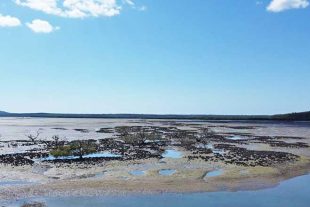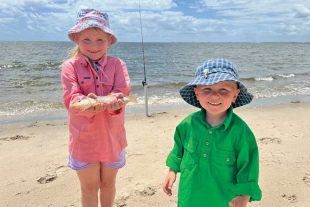While considered ‘old school’ by some in the fly or lure-only fraternity, the truth is bait fishing will always have a place in fishing, from the beginner to the experienced.
And while I love lure fishing in a variety of scenarios – from tossing lures off the beach to trolling lures for everything from mackerel to marlin in the salt – I still love bait fishing an assortment of options.
For a start, it is effective.
In fact, it is even more effective if the bait you are using is live.
Why?
Well obviously, the bait looks natural and, as it is secured with a hook, it is thus swimming erratically and sending out distress signals to fish who might see it as an easy meal.
So, let’s have a look at four key live bait options for the beach and estuaries, two of my favourite target areas.
Prawns
I’ll start with prawns because, going off their late start to the year and last season, the banana prawn run in southeast Queensland may go into June.
While banana prawns are sensational to eat, if you can spare a few and keep them alive in an aerator and bucket, they are a hot bait for anything from whiting to barramundi.

In Queensland, banana prawns are best caught with a 10”, or if you can manage it 12”, top pocket only cast net.
During the peak seasons of February to May, you then want to be searching for them in the deep holes of rivers and creeks.
If you are not exactly sure where, simply follow the scores of boats, particularly on weekends.
It is a fairly relaxed atmosphere in the prawning mosh pit, so don’t worry about joining the crowds, yet if you can find your own hole and prawns, it’s all the more rewarding.
An alternative way to target prawns, particularly tigers and bay prawns, is by using strong headlamps or underwater lights and prawn scoop nets.
I have used both types of lights, particularly strong LED lights on a do-it-yourself headlamp, which I have written about a few times in the past.
In the shallows of Moreton Bay, these prawns are in such shallow water that the underwater light is much less effective than a strong headlamp, which can search out the red beady eyes of the prawn from afar.
To keep these prawns alive, you ideally want to use them that day, but if not and you’re keeping them overnight, change the saltwater in your bucket or flat tray a few times.
Keep them well aerated with portable aerators or even a 24-volt fish tank aerator, if you have one.
Then, when it comes time to hook them up, a size 1 circle hook through the third last section of the prawn’s shell is ideal and will allow it to swim and kick about, attracting fish to investigate.

Saltwater yabbies
Saltwater yabbies are another awesome bait, as are freshwater crayfish or freshwater yabbies.
Saltwater yabbies are probably the second easiest bait to collect behind the pipi.
Yabbies will catch almost any fish that swims past them in the estuary, bay or the beach.
To catch them, all you need is a yabby pump.
While it might cost you around $70-90 for a quality stainless-steel pump, for the most part, it will last you a lifetime.
All you need to do is give the brass shaft and washers some oil from time to time and make sure you flush the sand out after each session to avoid it clogging up.
Then every few years, it’s worth replacing the 2” rubber washers for a couple of dollars before they wear out.
Finding yabbies isn’t that hard, though there are a few little tricks to avoid raising a huge sweat pumping on unproductive grounds.
On the sand flats, avoid the hard corrugated sand and instead look for holes in the softer sand, mixed with darker patches of mud and sand, this will hold yabbies.

A top spot in these areas are melon holes created by stingrays, which are filled with water on a low tide.
Likewise, look around the edge of the mangrove roots as another choice spot.
If you are consistently getting small yabbies, the spot may be over-used, so try a bit further away, particularly where the spot has easy access.
When you are lifting the pump out – on say the second or third pump down the hole – and hearing a ‘slurp’ noise, you know you’re in productive yabby territory of soft sand mixed with water under the surface.
Finally, another tip if you’re struggling to find them even after locating holes, is to look for holes with a fresh mound of dirt around the entrance.
This generally means the yabby is at home.
They are best kept alive in a shallow tray of saltwater with an aerator or two.
However, they will also survive a reasonable length of time in damp sawdust or seagrass.
Hooking them up, I like to use a small size 4 Tru-Turn finesse hook and go in through the underside of the tail, threading it up the tail and bringing it out in the harder breast plate area.
Beware of their nippers – pinch them either side of the base of their claws to avoid getting nipped.
One more tip for fishing them…
Rather than thrown with a strenuous cast that you might give a pilchard in the surf, as they are soft, yabbies should be ‘flicked’ out when cast.
As a consequence, a longer slow action or light whippy rods in the 1-3kg or 2-4kg range will help you achieve a reasonable cast without the yabby flying off.

Pipis
The easiest live bait of the lot to collect, particularly on beaches that permit four-wheel-drives on them, is the pipi.
Pipi mounds can be found exposed as lumps under 4WD tyre tracks at low tide on the firm wet sand near the water.
If your beach doesn’t permit 4WDs, the next option is to go down to the water’s edge, especially in the period between 90 minutes before to 90 minutes after low tide and do the pipi shuffle.
In particular, look for areas of fine wet sand rather than coarse sand to do this.
Basically, the pipi shuffle involves standing in the wet sand, or sand covered with a shallow layer of water, and twist both feet, allowing them to shuffle down into the sand.
If you then notice something hard underfoot, hold your foot on it and reach down and grab it.

It may be a stone, or worse, a small crab – so always look at what you are grabbing if you can – yet after a while, you’ll get to know the feel of a pipi.
In terms of baiting up, you can cut them into a couple of pieces, though I prefer to put a big bait on, which attracts on average bigger bream, tarwhine and flathead.
This is best fished on a baitholder hook.
I do this on a long-shank hook to increase my chances of hooking a whiting with their small mouths, as I prefer to eat them over bream, tarwhine and dart.
I basically thread the soft stomach over the hook a few times then secure it by pinning the tougher tongue over the top of it three times, by threading it in and out on the hook.
Beachworms
The king of all bait off the beach are live beachworms.
These sand-dwelling creatures can be cut into many bait, depending on their length, and will catch everything from whiting to mulloway.
Catching beachworms is a bit of an art, yet once perfected, it’s like riding a bike.
To set yourself up for beachworming, all you need is an old onion bag or a fish-keeper bag full of fish frames.
Try to avoid too much offal or pieces that will break off in it because the beachworms will grab them as the waves recede and then they’re gone.
The other crucial piece of worming gear is a firm finger bait of either a pipi or a firm piece of fish, such as that found on the underbelly of a fish.

The trick then is swishing the stink bag of fish frames around the top of the wash and watching for heads sticking up as the wave recedes.
This is best done two hours before and after low tide.
While you can still catch some different species of beachworm further up the beach towards high tide, the rush of the waves does get harder as the tide picks up pace.
Once spotted, you then approach the beachworm gently on the ball of your foot and let it grab the finger bait, then try to entice it out further ever so slowly.
Eventually it will ‘arch its back’ and, with your fingers under the sand and either side of it, this is the time to grip firmly with your thumb and forefinger around its head and commence a firm and medium-paced lift to pull it out of the sand.
I like to thread mine on a size 4 Tru-Turn hook in the surf for whiting, or longer sized 2/0 long-shank or baitholder hooks for mulloway, threading the whole worm on the hook by feeding it up and over the eye of the hook up the line.
So, there you go.
Four of the best live bait for the beach and estuary.
There are of course others such as live bloodworms that are awesome for whiting further up the estuary and live fish bait in the estuary, bays and offshore, however these four will stand you in very good stead.
 Bush ‘n Beach Fishing Magazine Location reports & tips for fishing, boating, camping, kayaking, 4WDing in Queensland and Northern NSW
Bush ‘n Beach Fishing Magazine Location reports & tips for fishing, boating, camping, kayaking, 4WDing in Queensland and Northern NSW









